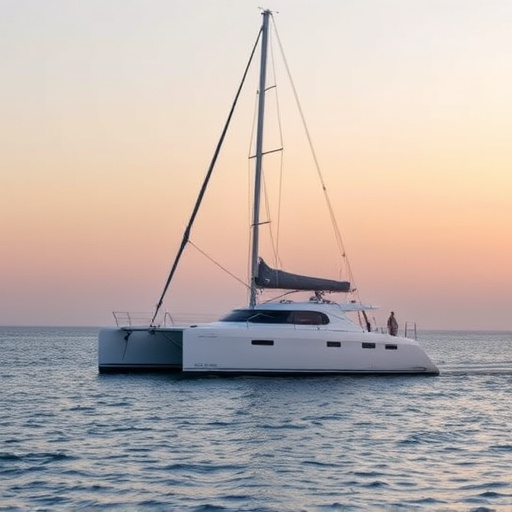Catamarans, with their dual-hull design, offer enhanced stability, speed, and maneuverability compared to monohull boats. Crafting a catamaran requires careful selection of materials like fiberglass and robust hardware for safety at sea. Building one involves layering fiberglass, constructing the deck and rigging, and thorough inspections. Launching demands meticulous preparation, followed by regular maintenance for optimal performance and longevity.
Discover the allure of sailing with a catamaran! This versatile vessel, defined by two hulls connected by a deck, offers stability and speed. In this comprehensive guide, we’ll explore what makes a catamaran unique and walk you through the building process from start to finish. From selecting components and materials to launching and ongoing maintenance, learn the secrets to constructing your own catamaran and embrace the freedom of the open waters.
- What is a Catamaran?
- Components and Materials for Building
- Step-by-Step Construction Guide
- Tips for Launching and Maintenance
What is a Catamaran?

A catamaran is a type of vessel that stands out for its unique dual-hull design, consisting of two parallel hulls joined by a structure, often a deck or a connecting bridge. This distinctive feature sets it apart from monohull boats and offers several advantages. Catamarans are known for their stability, as the dual hulls provide a broader base, making them less prone to rolling in rough seas. This design also allows for a larger surface area, which enhances buoyancy and reduces water resistance, resulting in improved speed and maneuverability.
Their versatility is another key aspect; catamarans can be found in various forms, from small recreational boats to large luxury yachts. They are popular among sailors due to their efficient use of space, as the dual hulls create more room for living quarters, storage, and amenities. This design also facilitates easier docking and mooring, making them convenient for navigation in crowded harbors or shallow waters.
Components and Materials for Building

Building a catamaran involves selecting robust components and materials that will ensure its strength, stability, and durability on open waters. The hull is a critical component, typically constructed from materials like fiberglass, wood (such as marine-grade plywood), or composite materials for enhanced buoyancy and maneuverability. These materials offer resistance to corrosion and are light enough to support the vessel’s structure without compromising speed or agility.
For the deck, choose non-slip surfaces like rubber or vinyl that provide a safe walking surface. Essential hardware includes robust bolts, hinges, and fittings designed to withstand marine conditions. Rigging, comprising cables and spars, plays a vital role in steering control. Opt for high-quality stainless steel or aluminum alloys for these components to ensure longevity and corrosion resistance. Additionally, consider the importance of a well-designed kee (a support post) and robust fin or flap for improved stability and maneuverability in varying sea conditions.
Step-by-Step Construction Guide

Building a catamaran is an exciting endeavor that allows you to create your own unique watercraft. Here’s a simplified step-by-step guide to help you navigate this process. Start by gathering the necessary materials and tools, including high-quality fiberglass sheets, resin, a mold for the hull (you can buy or create one), a design plan with specifications for size, and essential tools like scissors, sandpaper, and protective gear.
Next, construct the hull by cutting the fiberglass sheets to match your design and layering them over the mold using resin as an adhesive. Ensure each layer is smooth and properly aligned. Once the hull hardens, carefully remove it from the mold. Proceed with building the deck, rigging, and other structural components according to your plan. This involves attaching the hulls together, installing the deck, adding support beams, and fitting out the rigging for sailing. Regularly inspect each step, ensuring precision and stability for a safe and enjoyable catamaran experience.
Tips for Launching and Maintenance

Launching your catamaran is an exciting step, but it requires careful preparation and a few essential tips. First, ensure your craft is fully prepared by double-checking all equipment, including rudders, sails, and engines. A well-maintained pre-launch inspection is crucial for a smooth ride ahead. Once ready, find a suitable location with calm waters to launch; avoid strong currents or rough seas initially.
Regular maintenance is key to keeping your catamaran in top condition. This includes frequent checks of the hull, cleaning and servicing of engines, and regular polishing to protect the gel coat. Remember, proper storage is also vital; cover your catamaran when not in use and park it in a sheltered area to prevent damage from harsh weather conditions, which can save you time and money in the long run.
A catamaran, with its distinctive dual hulls, offers a unique sailing experience. By understanding what is a catamaran and employing the right components and materials, building your own can be an exciting project. Following a detailed step-by-step guide ensures a solid construction, while thoughtful tips for launching and maintenance will keep your catamaran sailing smoothly. Embrace the challenge and enjoy the fruits of your labor on the open waters—the ultimate catamaran adventure awaits!
